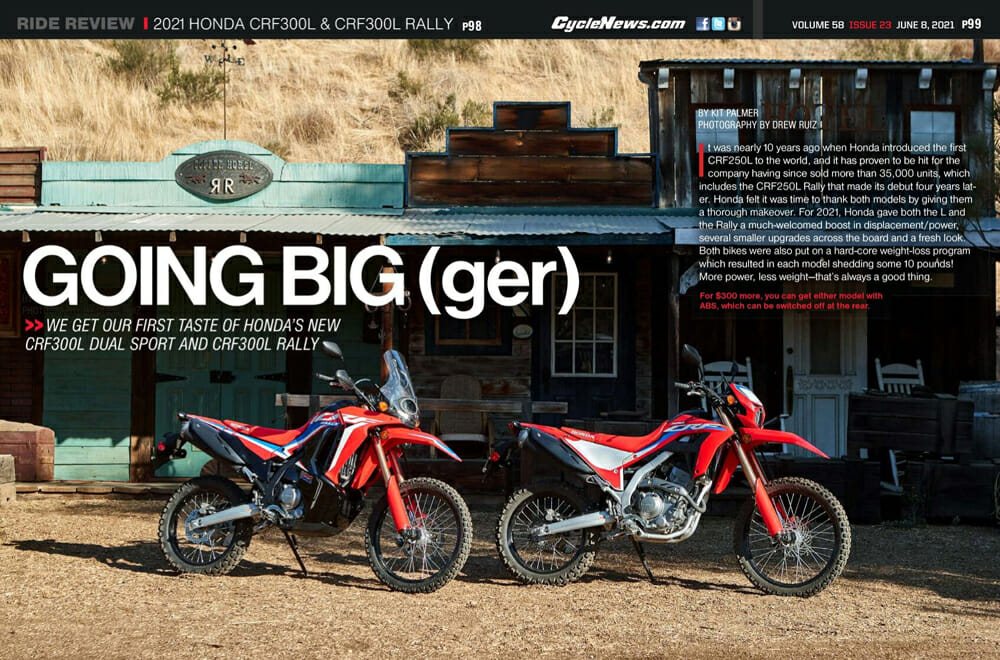Kit Palmer | June 11, 2021
We get our first taste of Honda’s new CRF300L dual sport and CRF300L Rally.
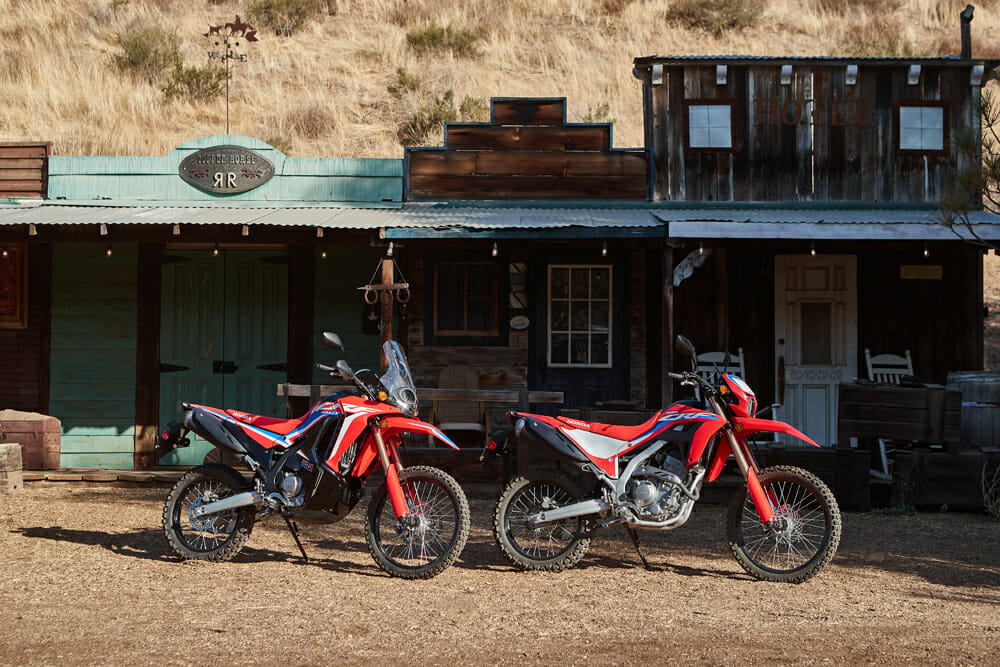 Very similar, but very different. The 2021 Honda CRF300L (left) and CRF300L Rally (right) look right at home on the dirt and in the country.
Very similar, but very different. The 2021 Honda CRF300L (left) and CRF300L Rally (right) look right at home on the dirt and in the country.
Photography by Drew Ruiz
It was nearly 10 years ago when Honda introduced the first CRF250L to the world, and it has proven to be hit for the company having since sold more than 35,000 units, which includes the CRF250L Rally that made its debut four years later. Honda felt it was time to thank both models by giving them a thorough makeover. For 2021, Honda gave both the L and the Rally a much-welcomed boost in displacement/power, several smaller upgrades across the board and a fresh look. Both bikes were also put on a hard-core weight-loss program which resulted in each model shedding some 10 pounds! More power, less weight—that’s always a good thing.
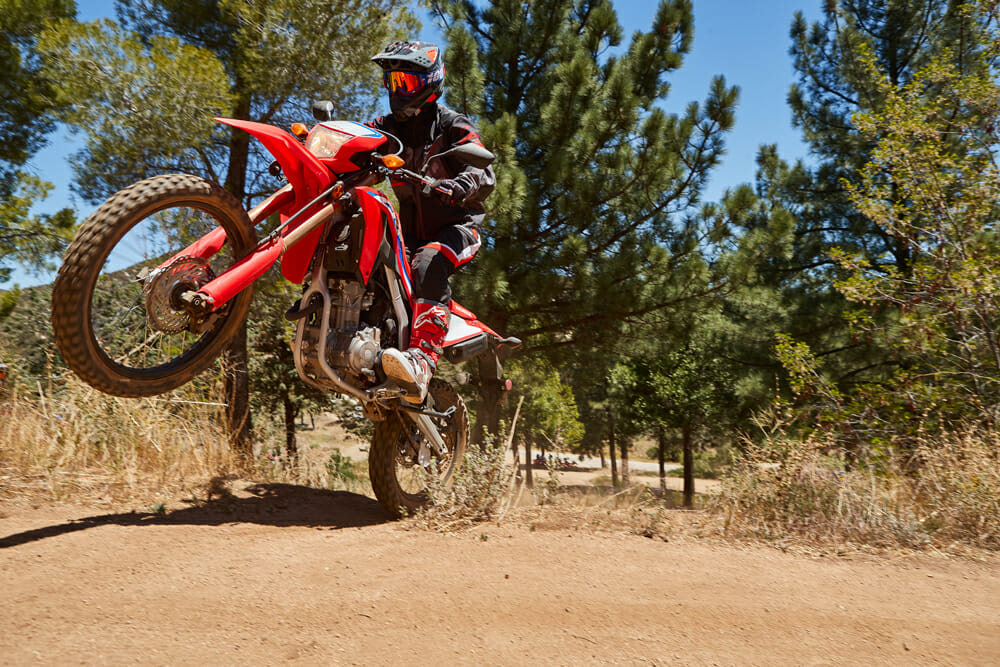 It’s amazing what a few more cc’s will do. The CRF300L has noticeably more power across the board than the outgoing CRF250L, making the new one even more fun to ride.
It’s amazing what a few more cc’s will do. The CRF300L has noticeably more power across the board than the outgoing CRF250L, making the new one even more fun to ride.
What’s New? | 2021 Honda CRF300L & CRF300L Rally Ride Review
Honda unveiled the CRF300L and CRF300L Rally back in early January, so we’ve had plenty of time to chew on the specs while waiting eagerly for the 300s to arrive. Both bikes share the same liquid-cooled, single-cylinder four-stroke engine that, compared to the previous 250cc engine, has 36cc more displacement for a total of 286cc. This was achieved by increasing stroke 8mm (to 63.0mm). The 76.0mm bore, however, was left unchanged. In addition, the camshaft’s lift and timing were revised to improve power in the lower and middle rpm range where this bike is expected to be ridden most.
Honda claims both the L and the Rally deliver 27 horsepower at 8500 rpm and max torque at 19.6 lb-ft at 6500 rpm.
More power means the need for more air, so the air cleaner and exhaust systems have been revised for improved flow, though the 38mm throttle body remains the same.
Both bikes feature six-speed transmissions with revised gear ratios—closer spacing in the lower gears and wider spacing in the higher gears.
The clutch now features slipper assist to improve shifting action when tapping down through the gears aggressively. Clutch pull has also been reduced by 25 percent, which is remarkable when you consider how light it was already.
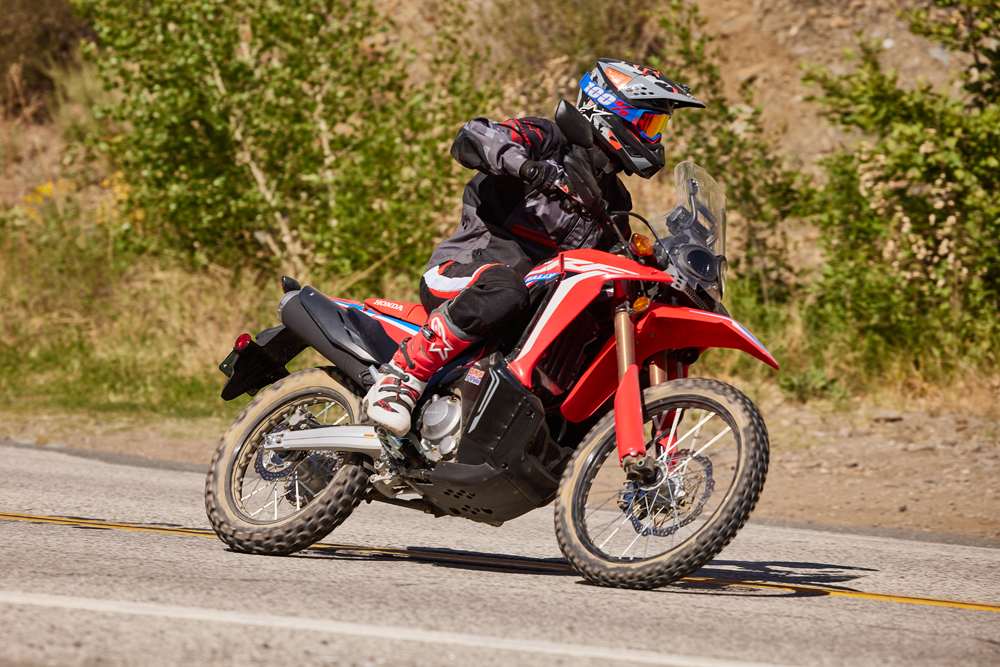 Want to look good riding around town? Then look no further than the CRF300L Rally.
Want to look good riding around town? Then look no further than the CRF300L Rally.
While dimensions stay the same, the frame received a lot of special attention that resulted in significant weight loss and changes in flex characteristics. Plus, the lower triple clamp is now constructed from aluminum instead of steel, and a new swingarm also contributes to the weight savings.
One thing that hasn’t changed from before is suspension, though the 300’s did get slightly more wheel travel at both ends. Both bikes share a straightforward 43mm Showa fork and a Pro-Link single-shock rear suspension system. Unfortunately, again, neither the fork nor the rear shock is adjustable except for spring preload in the back. We were told that, despite the Rally’s extra 20-plus pounds, they share the same spring rates.
A new digital dash features black characters on a white background, and those characters are 6mm larger for improved visibility. In addition to speed, clock and rpm readings, new functions have been added, including gear position, fuel mileage and fuel consumption. The entire unit is also slightly lighter.
The L and the Rally share the same brake system, except for the Rally’s 40mm larger-diameter (296mm) front disc. ABS is optional for both bikes and adds $300 to the price tag. On those models, the rear ABS can be disengaged for off-road riding.
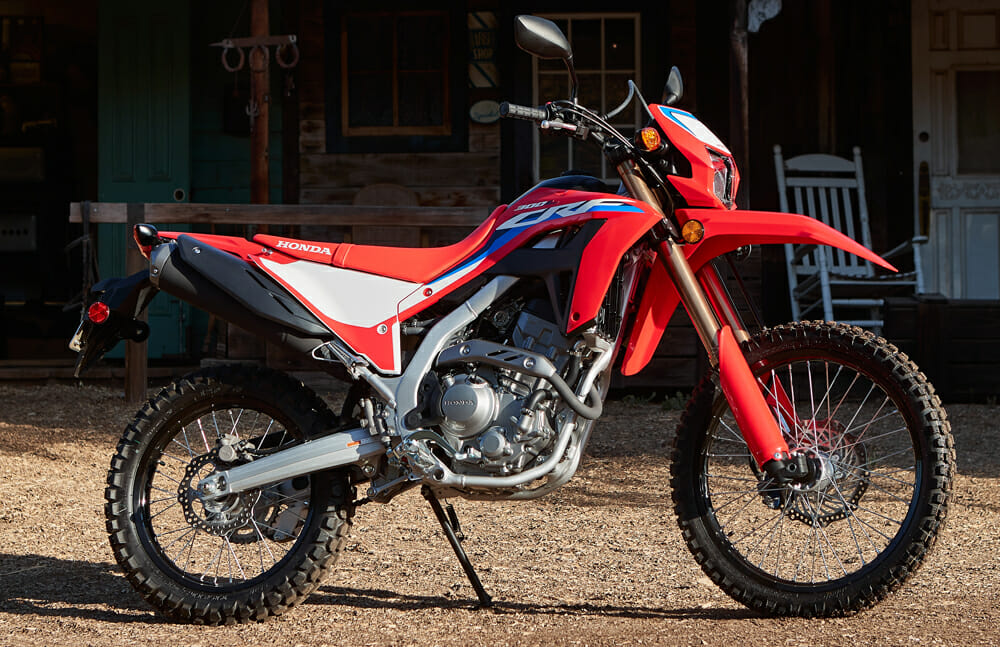 Like the Rally, the L is easy on the eyes. But we wish it had the blacked-out frame like the Rally.
Like the Rally, the L is easy on the eyes. But we wish it had the blacked-out frame like the Rally.
Apples To Oranges? | 2021 Honda CRF300L & CRF300L Rally Ride Review
So, what sets the Rally apart from the L? Well, the main differences are obvious. The Rally gets a small windscreen and a higher-capacity fuel tank. At 3.4 gallons, the Rally carries 1.3 gallons more fuel than the L.
Look a little closer and you’ll see that the Rally comes with an engine skid plate, the L does not.
Seat height is a tick higher on the Rally than the L, 34.8 inches versus the L’s 34.6 inches. And you have less ground clearance with the Rally at 10.8 inches versus the L’s 11.3 inches.
Like last year, both bikes come with polished black rims with the Rally again getting a blacked-out frame versus the L’s boring silver frame.
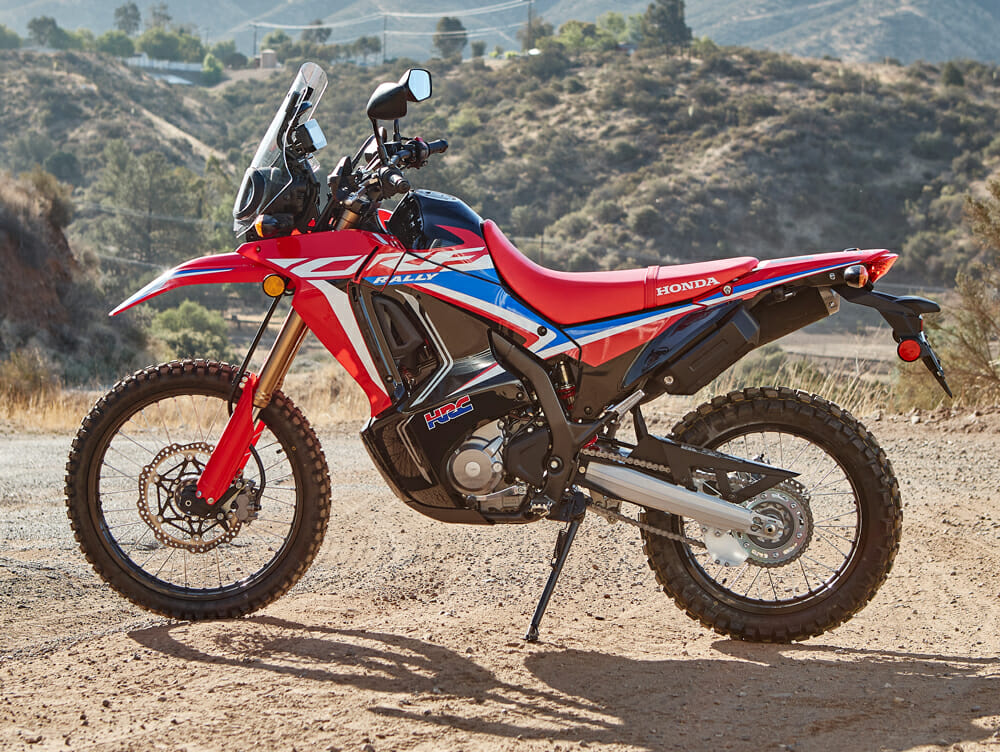 The Rally is designed for longer-distance riding as you can tell by the large fuel tank and windscreen. Honda also redesigned the cockpit to improve comfort.
The Rally is designed for longer-distance riding as you can tell by the large fuel tank and windscreen. Honda also redesigned the cockpit to improve comfort.
Honda made a few tweaks to the Rally to improve comfort for longer hauls, which Honda figures the Rally will be doing more of than the L. Handlebar sweep is increased for a “more natural elbow position and lighter steering,” and two handlebar weights (5.8 ounces each) were added to reduce vibration, and rubber platforms were added to the footpegs for the same reason. The Rally’s seat gets a new rubber mounting cushion, and it has been widened by a little more than half an inch compared to the standard model, to 7.5 inches, though the front remains narrow to facilitate the rider’s feet touching the ground when needed. Passenger pegs come standard.
The rider’s footpegs are also moved rearward, while the right swingarm-pivot cover is redesigned to reduce width.
The number-one difference between the two bikes that isn’t so obvious, but you can probably guess, is the Rally weighs more—approximately 24 pounds more—than the L. According to Honda, the Rally tips the scales at 333 pounds, the L 309 pounds (these are ready-to-ride figures, tack on a few more pounds for ABS).
The Rally cost more, too, at $5999. The L sells for $5249. Expect to pay approximately $300 more for the ABS models.
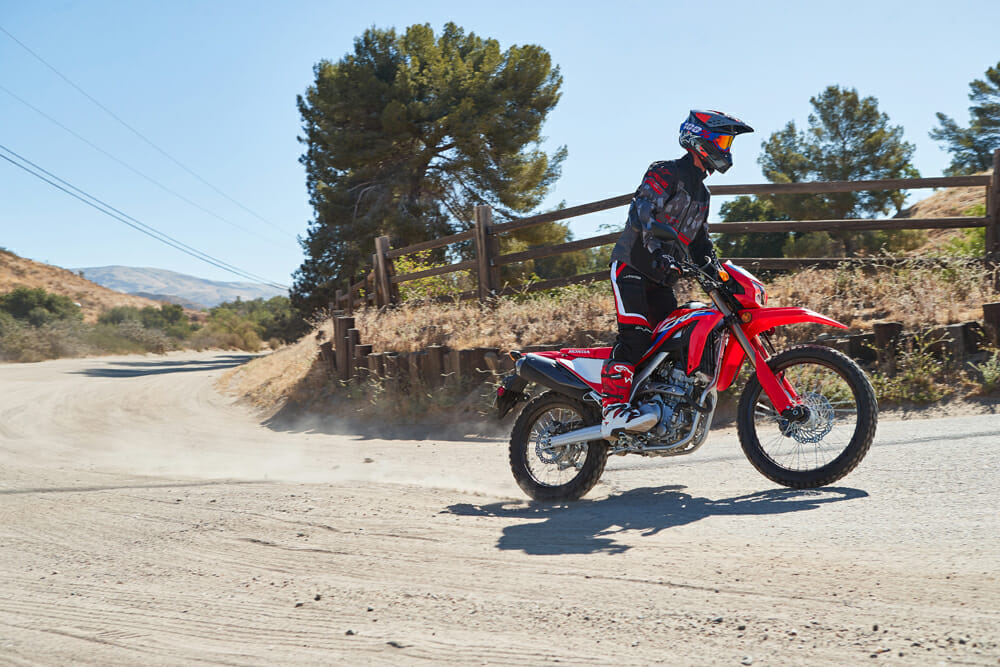 Once again, the CRF300L (and the new Rally) is fitted with non-adjustable suspension. It comes set up from the factory quite soft and spongy. Newer riders won’t mind, but more experienced riders will be seeking out the nearest suspension shop.
Once again, the CRF300L (and the new Rally) is fitted with non-adjustable suspension. It comes set up from the factory quite soft and spongy. Newer riders won’t mind, but more experienced riders will be seeking out the nearest suspension shop.
All Aboard | 2021 Honda CRF300L & CRF300L Rally Ride Review
Honda provided us with an introductory single-day guided tour in the back-canyon hills of Southern California. Since then, we’ve gotten some more seat time on the L and will be doing the same with the Rally very soon. But our first full day on both bikes revealed many things. First off, power is noticeably better on both bikes. It’s not a night-and-day difference but there is a difference, nonetheless. It’s been a while since I last threw a leg over either the 250L or the 250L Rally, but the new engine feels livelier overall with noticeably better bottom-end performance and improved torque. I felt like you didn’t have to scream the engine nearly as hard as you did on the 250 to find the power’s sweet spot. The 286cc engine chugs much better, which makes both bikes easier to ride on technical trails, hills and soft ground. I think the new gear ratios help here, as well.
Gear changing is improved, too. Missed shifts just never happened and clutch pull is indeed even lighter than before while still offering good feel and engagement.
On the pavement, the new engine hums along nicely at speed. It can handle 60 mph confidently and comfortably. As speeds and revs pick up, however, so do the vibes, which start to kick in noticeably about 7000 rpm. The Rally’s non-adjustable windscreen helps deter windblast off the rider’s midsection but redirects a steady stream of turbulent air onto the rider’s forehead, quite noticeable if you’re pushing six feet in height like I am.
The Rally is indeed better suited for long days in the saddle than the L mainly because of its windscreen, slightly more relaxed handlebar/seat/footpeg relationship and wider seat. You also feel slightly less vibration on the Rally at equivalent rpm, and the slightly lower seat height can be a bonus at times.
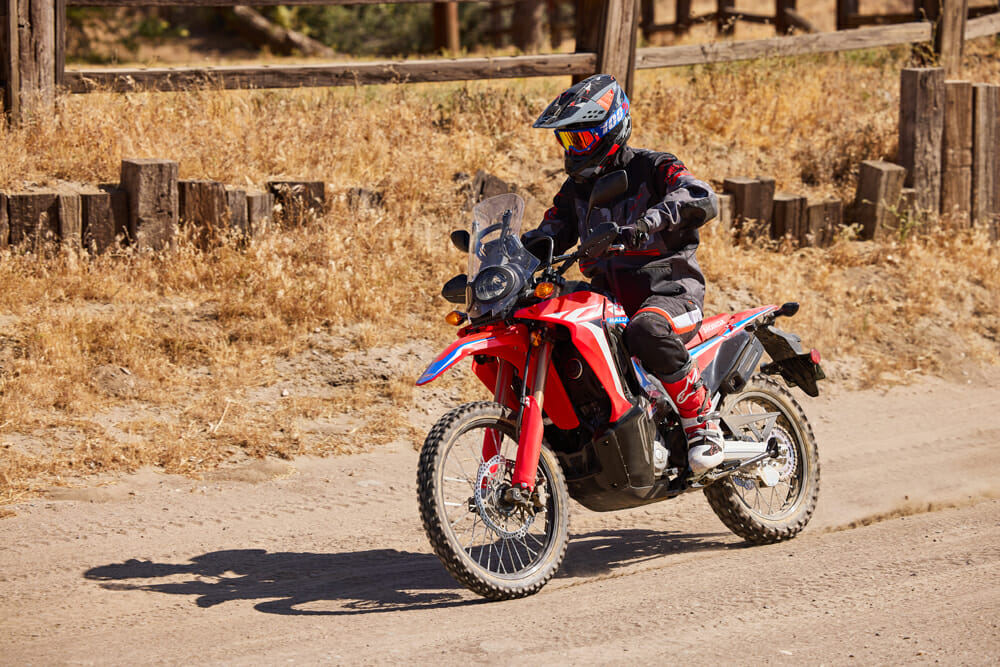 The Rally loves smooth dirt roads but can still handle the messy stuff surprisingly well.
The Rally loves smooth dirt roads but can still handle the messy stuff surprisingly well.
Speaking of seat height, at 34-plus inches for both bikes, I wouldn’t consider either bike feeling excessively tall or short, kind of in the middle of the road, but they are both about a half-inch lower than the Kawasaki KLX300, the CRF300L’s closest rival.
Like the previous 250, suspension is super cushy, perfect for casual riding and beginners but way under sprung for more experienced and heavier riders who like to keep the pace up on the trail. I could deal with the soft springs, but the shock is so under damped, both rebound and compression, the result is a pretty “springy” ride, at least it was for my 160-plus pounds. And since there are no damping adjustments, you have no choice but to live with it. Again, this might be fine and perhaps welcomed for those just entering the sport, but even they will out-grow the L’s suspension quickly. I didn’t have much issue with the soft springs on the pavement, either, but the lack of damping made for a sometimes “pogoey,” almost queasy, ride. This is the price we pay for Honda keeping the overall price down on both models. Higher-end suspension components would certainly drive MSRP way up, perhaps putting both L’s out of reach of most first-time buyers who are on the fence about getting a bike.
I wasn’t impressed with the brakes, either. Even though the all-important front brake has sufficient power, there just wasn’t enough initial grab for my liking, and I often found myself over-shooting turns on tight single-track until I got used to it and starting compensating. I must admit, though, the jury is still out on this one since the bike I rode was brand new and perhaps the pads had not bedded in yet, but even at the end of the day, it hadn’t improved much. However, the softer front brake isn’t a bad thing at all for newer riders, which is Honda’s target audience with these motorcycles anyway. The models I rode were not fitted with ABS, which I feel is a great option for both newbies and even experienced riders, since you can disable ABS in the rear at the push of a button.
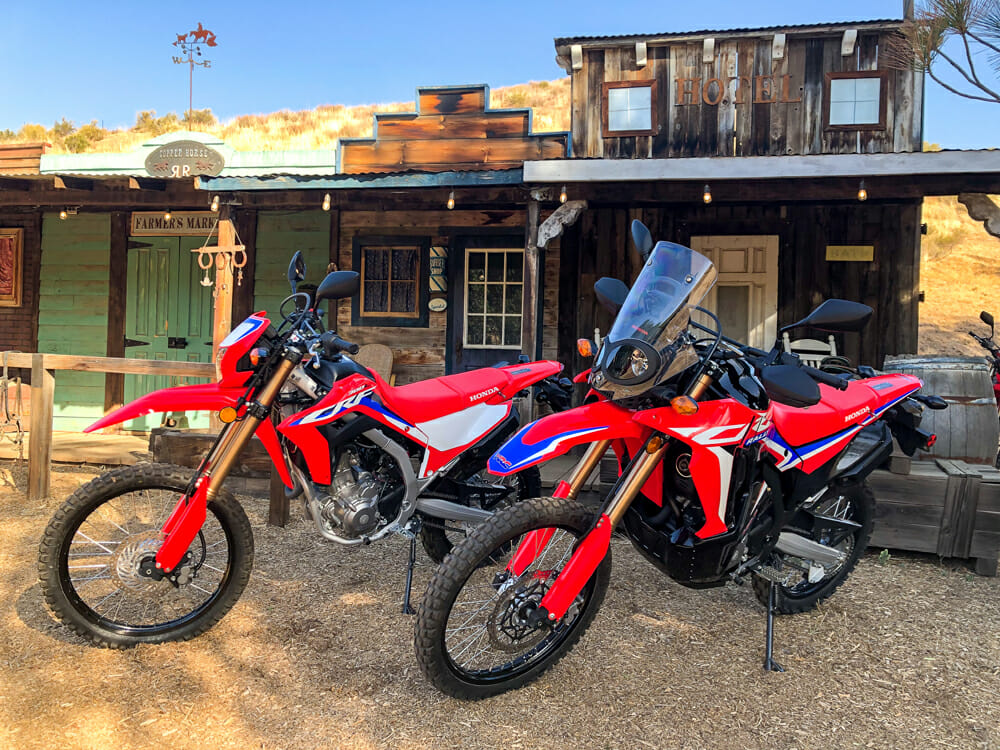 For $300 more, you can get either model with ABS, which can be switched off at the rear.
For $300 more, you can get either model with ABS, which can be switched off at the rear.
The new dash is awesome. I loved the huge digital MPH readout for easy reading at a glance when the sun is high in the sky and the screen is covered in dust. Plus, it gives you all the information you really need.
Overall, I thoroughly enjoyed riding both the 300L and the 300L Rally. I feel they are both much improved over their predecessors both on and off the trail.
I also feel that the more-powerful Rally is an upgraded shock and fork away from being a legit hard-core adventure-type motorcycle for someone looking for a simple and inexpensive, good-handling, lightweight, long-distance on/off-road cruiser that can tackle semi-technical terrain reasonably well. And you don’t have the stress of not being able to pick the bike up on your own in case you drop it in the middle of nowhere.
But probably best of all? Both bikes are lookers! The Rally is just plain beautiful, and the L looks like Ken Roczen’s factory Honda HRC race bike. Hey, if all you want is something to look good on as you ride around town, then here you go. But for their intended use, they also go as good as they look. CN
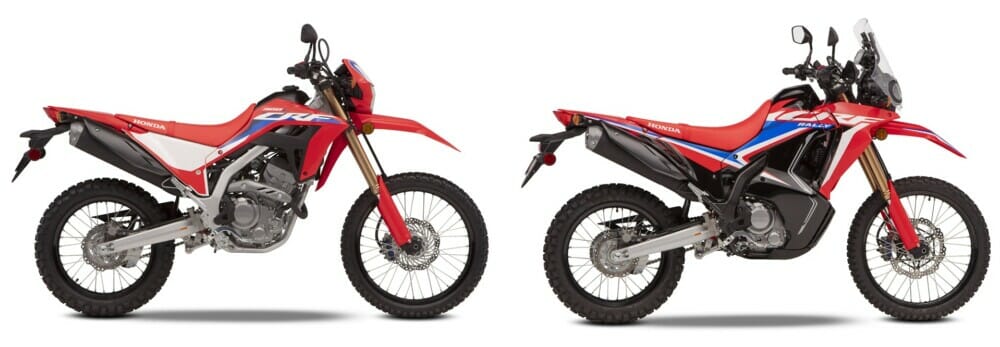
2021 Honda CRF300L / CRF300L Rally Specifications
| MSRP: |
$5249 / $5999 |
| Engine: |
four-stroke, single |
| Drivetrain: |
DOHC, 4-valve |
| Cooling System: |
Liquid |
| Displacement: |
286cc |
| Bore x Stroke: |
76.0 x 63.0mm |
| Compression Ratio: |
10.7:1 |
| Horsepower (claimed): |
27.0 hp at 8500 rpm |
| Torque (claimed): |
19.6 lb-ft at 6500 rpm |
| Oil Capacity: |
0.5 gal. |
| Fueling System: |
PGM-FI EFI, 38mm throttle body |
| Battery Capacity: |
12V-7AH |
| Clutch: |
Wet multiplate, assist/slipper |
| Transmission: |
6-speed |
| Final Drive: |
13T/40T / 14T/40T |
| Frame: |
Steel semi-double cradle |
| Swingarm: |
1-piece, cast aluminum |
| Front Suspension: |
Showa, 43mm, USD, telescopic for, non-adjustable |
| Rear Suspension: |
Showa, single shock, Pro-Link, preload adjustable |
| Front-Wheel Travel: |
10.2 in. |
| Rear-Wheel Travel: |
10.2 in. / 10.4 in. |
| Front Brake: |
256mm disc w/2-piston caliper; optional 2-channel ABS / 296mm disc w/2-piston caliper; optional 2-channel ABS |
| Rear Brake: |
220mm disc w/1-piston caliper; optional 2-channel ABS |
| Front Tire: |
80/100-21 in. |
| Rear Tire: |
120/80-18 in. |
| Wheelbase: |
57.2 in. / 57.3 in. |
| Rake: |
27°30’ |
| Trail: |
4.3 in. |
| Seat Height: |
34.6 in. / 34.8 in. |
| Ground Clearance: |
11.2 in. / 10.8 in. |
| Fuel Capacity: |
2.1 gal. / 3.4 gal. (incl. .6 gal. reserve) |
| Weight (curb, claimed): |
309 lbs. (311 lbs. ABS) / 333 lbs. (337 lbs. ABS) |
